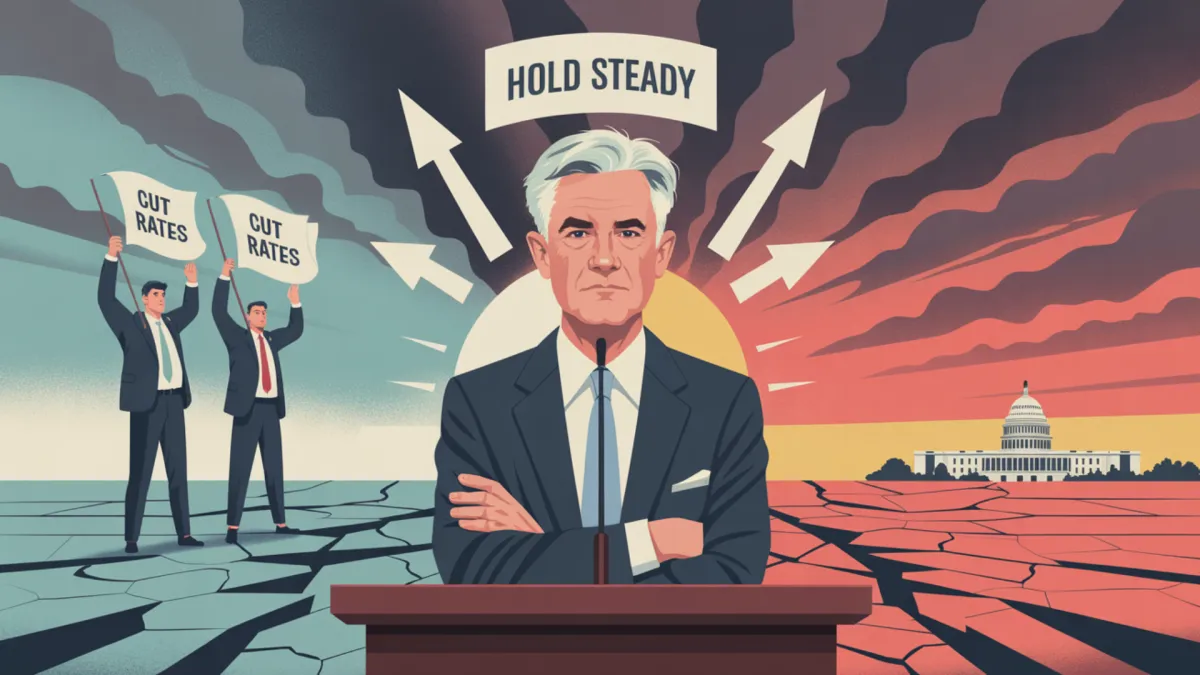
Fed Faces Sharp Divide as Powell Resists Rate Cuts
A Divided Fed: Powell Faces Mounting Dissent Amid Shifting Economic Winds
The Federal Reserve, historically seen as a unified and steady guiding force for U.S. economic policy, now faces its deepest internal division in over three decades. Fed Chairman Jerome Powell, long known for a cautious and measured approach, is finding it increasingly difficult to maintain consensus among fellow policymakers.
At the Fed's most recent policy meeting, the tension boiled over: two Fed presidents openly pushed for an immediate interest rate cut, a bold and public break from Powell’s refusal to adjust current policy.
This high-profile split is especially notable because such visible dissent hasn’t occurred in over 32 years. While internal debates are nothing new for the Fed, this level of disagreement underscores growing concerns about whether current policy decisions are still aligned with real-time economic indicators. Yet despite these internal calls for change, Powell remains firmly committed to his position, resisting any shift toward easing.
A Backward-Looking Policy in a Forward-Moving Economy
Right now, the Federal Reserve holds a notably restrictive monetary policy stance—a position that was arguably justified in 2022 and early 2023, when inflation hit a 50-year high. But that same policy appears increasingly outdated as inflation has cooled considerably in recent months. Many market participants and economic analysts argue that monetary policy should evolve to reflect this changing environment.
Unfortunately, the Fed appears stuck in the past, continuing to base decisions on lagging data rather than forward-looking indicators. This disconnect is not just a strategic misstep—it risks amplifying economic harm.
Powell continues to cite trade tariffs and potential inflation rebounds as justification for keeping rates elevated. But many experts believe these risks are either overstated or already priced in by the market. In fact, recent economic data points to a slowdown in key sectors, suggesting the time for more accommodative policy has arrived.
Room to Cut—and Reason to Do It
According to multiple analysts, the Fed could cut its benchmark overnight lending rate by as much as 1.5% without risking inflation. Such a move would bring policy closer to a neutral rate, better supporting economic growth without triggering excessive price pressures.
One of the clearest arguments for easing monetary policy is the ongoing softness in the labor market. Job growth has not only slowed, but recent reports have been repeatedly revised downward—casting doubt on the notion of a still-overheating economy. Holding rates high under these conditions may prolong financial strain on American households, small businesses, and even government borrowers.
Delayed Reactions Have Consequences
The Fed has a track record of acting too slowly. Whether during the Great Recession or post-COVID recovery, its policies often lag behind market realities. This delay creates a cycle of instability where corrective actions come only after significant economic damage has occurred. A reactive Fed—rather than a proactive one—leads to deeper market corrections, volatility, and missed opportunities to cushion downturns.
When High Rates Hurt More Than Help
While banks might temporarily benefit from higher interest rate spreads, the broader cost to the economy is steep. Elevated rates drive up debt service costs for federal, state, and household budgets alike. This diverts capital from productive investment and growth into paying off existing debt.
The result? Slower business activity, reduced home buying, shrinking consumer spending, and a higher risk of recession. What once looked like a prudent inflation-fighting tool now looks more like an economic handbrake.
The September Showdown
With prominent Fed presidents breaking ranks and Powell’s credibility under pressure, the upcoming September FOMC meeting could mark a turning point. If dissent intensifies and economic data continues to soften, Powell’s influence could erode further. A deeply divided Fed is not just an internal problem—it’s a signal to global markets that U.S. economic policy lacks coherence.
Analysts are already questioning Powell’s long-term viability as Fed Chair. His term ends next year, and if economic pain deepens while inflation stays low, his reappointment may be unlikely.
A Defining Moment for the Federal Reserve
The Fed is facing more than just a disagreement on numbers—this is a clash of economic philosophies. One side argues for proactive adaptation to new realities; the other remains anchored to outdated fears. The stakes are high. If the central bank continues down its current path, it may sacrifice growth and stability for a ghost of inflation already conquered.
Whether Powell adjusts course or continues to resist, the Fed stands at a defining juncture. The choice is between staying rigid or embracing flexibility in the face of a rapidly changing economic landscape.
